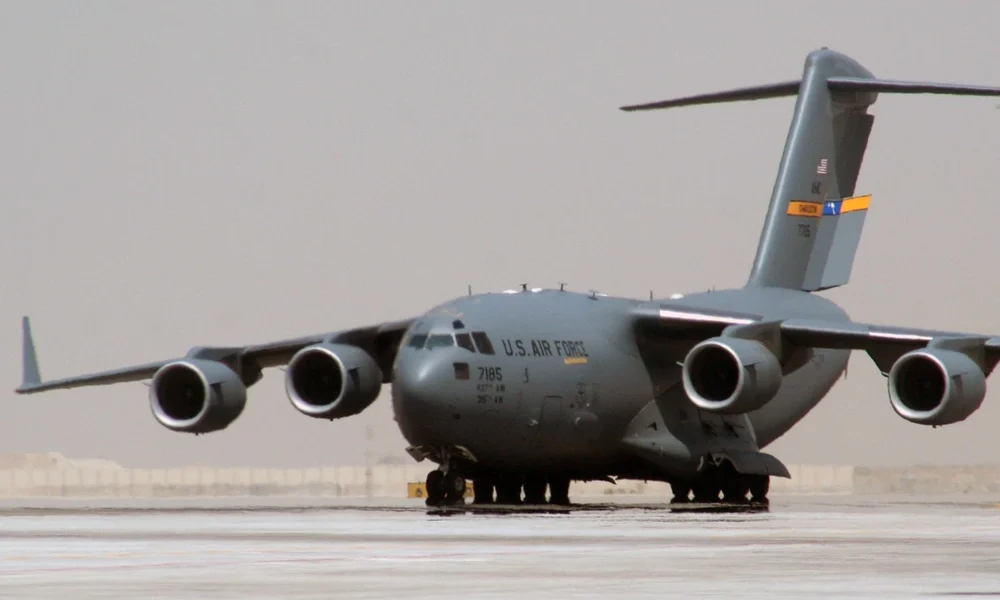C-17 Cargo: Global Mission Capabilities

The Versatility of the C-17 Globemaster III
The C-17 Globemaster III is a high-wing, four-engine, T-tailed military transport aircraft. Developed for the United States Air Force (USAF), this aircraft became operational in 1995. Its design focuses on flexibility, quick deployment, and worldwide reach. The C-17 has become a vital part of U.S. military airlift capability.
Design and Development
The design process for the C-17 began in the 1980s. The USAF intended to replace the aging C-141 Starlifter fleet. The primary goal was to enhance airlift capacity and improve strategic operations. McDonnell Douglas, which later merged into Boeing, won the contract.
One key feature is its wing design. The high wings accommodate large cargo loads. Four Pratt & Whitney F117-PW-100 turbofan engines enable the aircraft to perform rapid takeoffs and landings. The engines offer thrust reversers to back up on a runway, unique for an aircraft of its size. Advanced avionics and a glass cockpit also modernize its operation.
Cargo and Capacity
The C-17 is designed for versatility in cargo load. It can carry up to 170,900 pounds of cargo. This capability is not limited to standard goods; it also includes military vehicles, equipment, and troops. It is large enough to transport an M1 Abrams tank.
The cargo bay features continuous tie-down systems. These systems secure cargo ranging from small items to large vehicles. The loadmaster ensures proper placement and balance. The rear ramp can lower even in-flight for airdrop operations. Special equipment onboard helps with rapid loading and unloading.
Global Deployment
A significant advantage of the C-17 is its global reach. It can land on runways as short as 3,500 feet and as narrow as 90 feet wide. This ability extends its operational range to austere and remote locations. It operates from both paved and unpaved runways.
High fuel efficiency allows for reduced need for refueling. The C-17 can carry fuel internally and with additional tanks if required. Its operational range without refueling is about 2,420 nautical miles, fully loaded. In-flight refueling extends this range, making long-distance missions feasible without landing.
Military Operations
The C-17’s primary role involves troop and equipment transport during military operations. Its various missions include tactical airlifts, strategic airlifts, medical evacuations, and humanitarian aid delivery. Units can deploy rapidly from the home base to operational areas worldwide.
Humanitarian missions utilize its airdrop capabilities. Supplies can reach isolated regions after natural disasters. For medical evacuations, interior configurations can accommodate litters and medical personnel. The versatile design shifts between roles as required by mission specifics.
Operational Units
The USAF operates the majority of C-17s worldwide. Besides the U.S., several allied nations employ the C-17. Notable users include the United Kingdom, Australia, Canada, India, and NATO forces.
The 437th Airlift Wing, stationed at Charleston Air Force Base, is a primary unit operating C-17s. Other bases include Joint Base Lewis-McChord and March Air Reserve Base. These units train continuously to maintain readiness.
Modern Innovations
Since its introduction, the C-17 has seen several upgrades. Avionics systems modernized to improve navigation and communication. Advanced countermeasure systems enhance flight security during operations. Software updates streamline flight management systems.
Upgrade pathways keep the fleet efficient and reliable. Efforts to develop sustainable fuel options are ongoing. Boeing and the USAF partnership ensures that the aircraft rises to meet modern challenges.
Training and Simulation
The operation of the C-17 requires specialized training. Pilots and loadmasters undergo rigorous programs. Simulators replicate real-flight conditions. This training is crucial for mission success.
Simulators provide pilots with emergency response training. Virtual environments create different weather scenarios. Loadmasters practice cargo loading and airdrop procedures safely. Training ensures proficiency in all potential situations.
Environmental Impact
Military aircraft often face scrutiny regarding environmental impact. The C-17 employs several measures to mitigate this. Low-bypass turbofan engines reduce noise and emissions. Continuous technology improvements aim for greater fuel efficiency.
Advanced navigation systems contribute to optimized flight paths. This reduces unnecessary fuel consumption over long distances. Overall, the C-17 strives for reduced environmental footprint in all operations.
Community and Global Contribution
The role of the C-17 extends beyond military operations. Communities benefit from its capabilities in disaster relief. Earthquakes, hurricanes, and tsunamis often call for its help delivering aid rapidly. Its global presence reinforces international cooperation during crises.
Coalition missions frequently involve the C-17. It provides essential support in shared security objectives. Its robustness ensures reliability in joint operations, reinforcing peacekeeping efforts worldwide.
Future Prospects
Continuation of the C-17 fleet depends on ongoing innovations. Upgrades will focus on enhancing operational agility and efficiency. Prospects include exploring autonomous operation capabilities. Such advancements aim to extend the aircraft’s service life well into the future.
Research into sustainable aviation fuels is ongoing. Developing eco-friendly options aligns with global environmental goals. The C-17 remains a cornerstone of strategic airlift planning for decades to come.
Recommended Aviation Gear
David Clark H10-13.4 Aviation Headset – $376.95
The industry standard for aviation headsets.
Pilots Handbook of Aeronautical Knowledge – $25.42
Essential FAA handbook for every pilot.
As an Amazon Associate, we earn from qualifying purchases.
Subscribe for Updates
Get the latest articles delivered to your inbox.
We respect your privacy. Unsubscribe anytime.